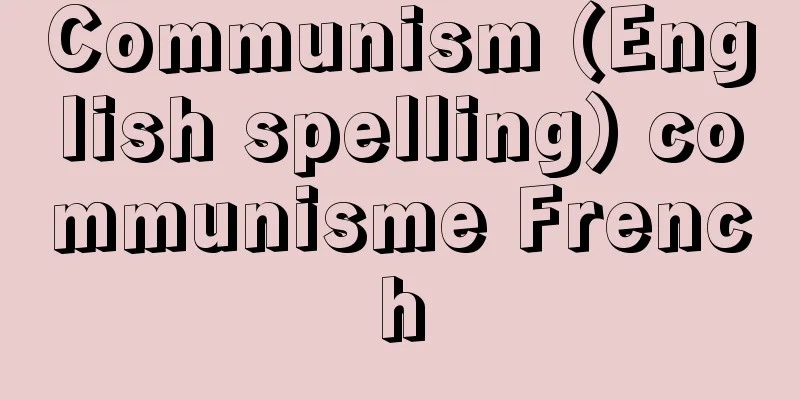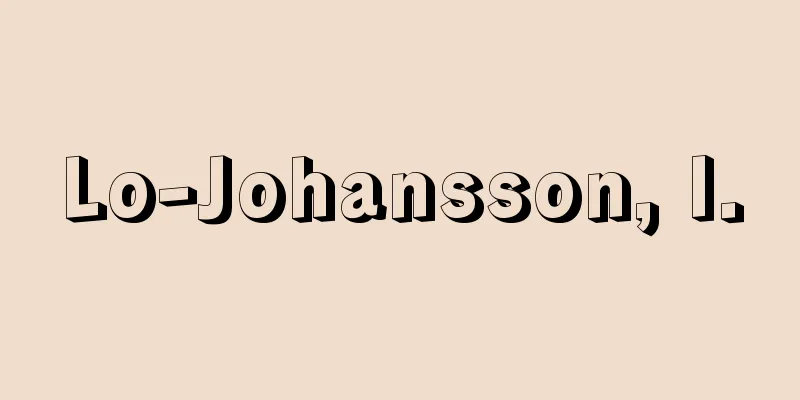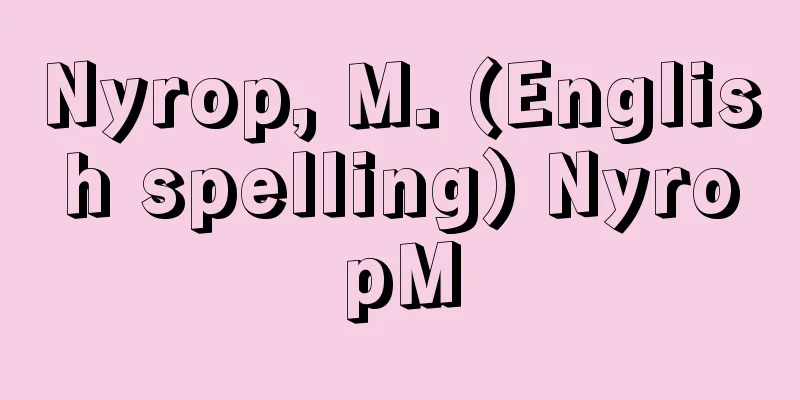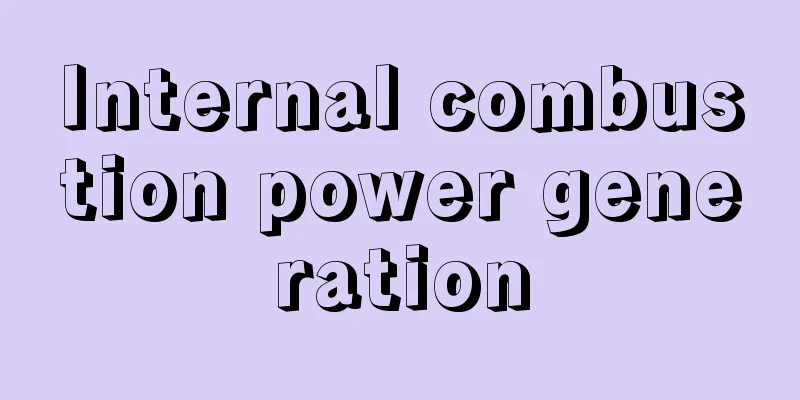Communism (English spelling) communisme French

|
The word communism comes from the Latin word commune. Communism and socialism as an ideology emerged in Western Europe from the late 18th century to the early 19th century, and advocated the abolition of private property and the transfer of property to some kind of community (commune). [Tsuneo Inako] Marx and Engels' CommunismThere were many different communist and socialist ideas at the time, but Marx and Engels' Communist Manifesto (1848) criticized feudal socialism, petty-bourgeois socialism, "true" socialism, conservative or bourgeois socialism, and critical-utopian socialism or communism. Unlike earlier communist and socialist ideas that rejected capitalism ideologically, Marx and Engels elucidated the laws of capitalist development and predicted the transition from capitalism to communism as a result of the development of productive forces and the contradictions in the relations of production. They also created the theory that communism would be realized through a working class revolution, thereby linking the idea of communism to the international communist movement. Marx and Engels divided communism as a social system into two stages. In the first stage of communism (now called socialism), the means of production are concentrated in the hands of the state, thus abolishing private ownership, but income is distributed to individuals according to their labor, so that differences in income among people remain. The transition from capitalism to the first stage of communism requires the dictatorship of the proletariat, which means the political rule of the working class. The second stage is a more advanced, complete communism: a society in which the productive forces and the morality of the people are highly developed, the individual is completely liberated, self-managed organizations take the place of the state to manage society, and the distribution of products to individuals is based on their needs, thus realizing equality in life. [Tsuneo Inako] Soviet CommunismThe success of the socialist revolution (October Revolution) in Russia in 1917 meant that communism had moved from being a mere movement to a new stage in which it had a state whose mission was to realize communism. The Russian Social Democratic Labor Party (Bolsheviks), which succeeded in the revolution, changed its name to the Russian Communist Party (Bolsheviks) in 1918, which later became the Communist Party of the Soviet Union, and the Communist International (Comintern, dissolved in 1943), which was formed in 1919, unified the names of the parties in each of the member countries to Communist Party. Since then, the activities of the communist parties in each country have been called the communist movement. For a long time, the Russian (Soviet) revolution and socialist construction served as the only precedent and model for communist movements in other countries. However, it was commonly believed that there were many unique aspects of the Soviet experience and theory that could not be generalized. Marxist literature did not strictly distinguish between socialism and communism, but after the October Revolution, the first stage of communism as Marx called it socialism, and only the second stage of communism was called communism. The immediate task in post-revolutionary Russia (Soviet Union) was the construction of socialism, but this task was carried out in conjunction with the reconstruction of the national economy destroyed by the war and overcoming economic backwardness by developing heavy industry. In particular, the integration of the huge number of peasant farms into socialist management was thought to require a long period of time in the early 1920s under Lenin's leadership. In reality, under Stalin's leadership, the industrialization of the national economy was achieved from the end of the 1920s to the beginning of the 1930s, and a policy was also enforced to integrate individual farms into kolkhoz, a productive agricultural cooperative, and by the mid-1930s, a socialist system was established in all areas of the national economy in the Soviet Union. The socialist system that was born in this way had many problems, so the 1936 Soviet Constitution, enacted under Stalin's leadership, described the strengthening of the socialist system but made no mention of the next task, which was to build communism. The Soviet political system, which had the ultimate goal of building communism, was also influenced by the situation in which the Soviet Union found itself. The model presented immediately after the revolution was to organize the state as an organization of the workers themselves, so that the workers would not simply elect representatives, but the entire population would participate in the governance of the state on a daily basis, thus eliminating bureaucracy and preparing for the death of the state. At the same time, in the difficult political situation immediately after the revolution, the realistic demand to establish a strong dictatorship of the proletariat took precedence, and therefore democracy was restricted. The 1936 Soviet Constitution eliminated these restrictions and established a democratic system centered on elections, but did not mention individuals' direct participation in governance. Even after the Constitution was enacted, Stalin insisted that the Soviet Union was still a state of the dictatorship of the proletariat, and under his leadership, the democratic provisions of the Constitution were not observed, and the political rights of individuals were not respected, resulting in the creation of a bureaucratic governance system centered on administrative organizations. After Stalin's death in 1953, the Soviet Union emphasized the need to adhere to the socialist democracy stipulated by the Constitution. The Communist Party of the Soviet Union, under the leadership of Khrushchev, went a step further and adopted the proposition in 1959 that the Soviet Union was in a period of comprehensive construction of communism. The party's platform of 1961 confirmed the end of the dictatorship of the proletariat and established a 20-year plan for the transition to communism. According to this, due to the rapid development of the national economy, the Soviet Union would become the world's number one in per capita income by 1980, at which point one-third of the consumer goods necessary for daily life would be distributed free of charge. According to this platform, some functions of the state, especially the function of maintaining social order, would be transferred to voluntarily organized social self-management organizations, and the state organizations would be reduced accordingly. In addition, the system of public election of state organizations would be expanded, the repeated re-election of the same person would be restricted, the members of executive organizations would be systematically replaced, ordinary workers would participate in administration in their spare time, and the number of paid civil servants would be reduced. This process would transform the state itself into an organ of social self-management, but the Party Program did not specifically state how to expand individual rights and freedoms in the construction of communism. After Khrushchev was dismissed in 1964, the proposition that the Soviet Union was in the period of comprehensive construction of communism was retracted. Instead, the 1976 Soviet Constitution, enacted under Brezhnev's leadership, confirmed the proposition that the Soviet Union was in the stage of developed socialism preparing for the transition to communism, and that this stage would last for a considerable period of time. It set out the development of socialist democracy, the expansion of the participation of social organizations, labor groups, and individuals in the management of state and social affairs, the realization of efficient economic management, and the development of individual rights and freedoms as its tasks. However, after the Constitution came into force, reforms in the management of the national economy and reforms to guarantee individual rights and freedoms did not progress. In 1983, under the leadership of Andropov, the Plenum of the Central Committee of the Communist Party of the Soviet Union decided that the Soviet Union was only at the beginning of developed socialism, and that improving developed socialism was a strategic task. Andropov also said that war must be declared on the state in which the operation of democratic institutions had become merely formal. This line was continued by Chernenko after his death in 1984. Under these circumstances, any premature discussion of the future of communism in the Soviet Union disappeared, and the Soviet Union collapsed in 1991. [Tsuneo Inako] Communism in EuropeCzechoslovakia's 1960 Constitution set out the immediate task of building communism, but this was entirely premature. The events in the Czech Republic in 1968 and the situation in Poland in the early 1980s (the birth of the independent trade union Solidarity and the subsequent imposition of military rule) showed that failure to reform the socialist system would lead to a serious political crisis. Most Eastern European countries were aspired to reform, but Hungary, among them, sought to revitalize political life by basing it on factory democracy. Since the 1950s, the former Yugoslavia had based its entire political system on the self-management of enterprises. In the Soviet Union and Eastern European countries, the Communist Party had established a strong leadership system. Some Eastern European countries had a multi-party system, but the status of parties other than the Communist Party was low. The idea that true freedom of the individual could be realized through participation in politics through groups and organizations was also dominant, and in contrast, freedom of the press and other political freedoms were not fully guaranteed. The Communist Parties of Western European countries and Japan were critical of socialism in this state, and in the 1970s, a trend called "Eurocommunism" emerged, which aimed for a socialism in which multiple parties, especially opposition parties, existed and political freedom was completely guaranteed. However, in the second half of the 1980s, Eastern European countries democratized and abandoned communism. [Tsuneo Inako] Chinese CommunismIn China, after the founding of the People's Republic of China in 1949, there was a conflict between the policy of steadily building socialism and the policy of Mao Zedong, who advocated rapid socialization. In 1958, under Mao's leadership, a policy of communistizing the entire rural areas in one fell swoop was implemented. In other words, farmers were organized into huge people's communes modeled on the military, farm work was done according to orders, and meals were provided collectively for free, in what is known as barracks communism. This measure destroyed agricultural production, and the leadership of the Chinese Communist Party was divided over how to resolve it. In 1966, the Mao faction began to oppress opponents through the "Cultural Revolution." After Mao's death in 1976, the Chinese Communist Party moved away from Maoism and set forth a policy of "four modernizations" of industry, agriculture, national defense, and science and technology, but did not set forth political modernization. During Mao's era, China admirers emerged among the left wing in various countries, including Japan, but post-Mao China has lost its ideological influence abroad. [Tsuneo Inako] "The Communist Manifesto by Marx and Engels, translated by Ouchi Hyoe and Mukaizaka Itsuro (Iwanami Bunko)" ▽ "The Communist Manifesto: The Principles of Communism by Marx and Engels, translated by ML Institute (Otsuki Shoten, Kokumin Bunko)" ▽ "Critique of the Gotha Programme by Marx, translated by Mochizuki Seiji (Iwanami Bunko)" ▽ "From Utopia to Science by Engels (translated by Ouchi Hyoe, Iwanami Bunko/translated by Terasawa Tsunenobu, Kokumin Bunko)" ▽ "State and Revolution by Lenin (translated by Utaka Motosuke, Iwanami Bunko/translated by the Publication Committee for the Complete Works of Lenin, Kokumin Bunko) " ▽ "Marxism by Yamanaka Ryuji, Modern Socialism by Inako Tsuneo and Kato Tetsuro" (included in the Dictionary of Social Thought, 1982, Chuo University Press)" ▽ "Five Communisms, volumes 1 and 2, by G. Martinez, translated by Kumada Toru (Iwanami Shinsho)" ▽ "What is Communism?" by R. Medvedev, translated by Kiyoto Ishido (1974, Sanichi Shobo) [References] | | | | | | |Source: Shogakukan Encyclopedia Nipponica About Encyclopedia Nipponica Information | Legend |
|
共産主義ということばはラテン語のコムーネcommuneに由来する。思想としての共産主義、社会主義は18世紀末から19世紀前半の西欧で生まれ、それらは、私有財産制度をなくし、財産をなんらかの共同体(コンミュンcommune)の所有に移すことを主張した。 [稲子恒夫] マルクス、エンゲルスの共産主義当時はさまざまな共産主義、社会主義の思想があったが、マルクスとエンゲルスの『共産党宣言』(1848)は、封建的社会主義、小ブルジョア社会主義、「真正」社会主義、保守的社会主義またはブルジョア社会主義、批判的・ユートピア的社会主義または共産主義を批判している。資本主義を観念的に否定する初期の共産主義、社会主義と違い、マルクスとエンゲルスは、資本主義の発展法則を解明し、生産力の発展と生産関係の矛盾の結果として、資本主義から共産主義への移行を予測するとともに、共産主義は労働者階級の革命により実現されるという理論を創造し、これにより共産主義の思想を国際的な共産主義運動と結び付けた。 マルクスとエンゲルスは社会体制としての共産主義を二つの段階に分けた。共産主義の第一段階(現在の用語では社会主義)では、生産手段は国家の手に集中され、したがってその私的所有は廃止されるが、個人への所得の分配は各人の労働に応じて行われ、そのため人々の所得の差は残る。資本主義から共産主義の第一段階への移行期は、労働者階級の政治的支配を意味するプロレタリアート独裁を必要とする。第二段階は、もっと高度な、完全な共産主義である。それは、生産力と人々の道徳が高度に発展し、個人が完全に解放される社会であり、国家にかわる自主管理の組織が社会を管理し、個人への生産物の分配は、各人の必要に応じて行われ、したがって生活における平等が実現する。 [稲子恒夫] ソ連の共産主義1917年のロシアでの社会主義革命(十月革命)の成功は、共産主義が単なる運動から、共産主義の実現を任務とする国家をもつという新段階が生まれたことを意味する。革命に成功したロシア社会民主労働党(ボリシェビキ)は、1918年に党名をロシア共産党(ボリシェビキ)=のちのソ連共産党に変え、19年に結成の共産主義インターナショナル(コミンテルン。1943年解散)は、加入の各国の党の名称を共産党に統一した。以後は各国共産党の活動が共産主義運動とよばれている。各国の共産主義運動では、長い間、ロシア(ソ連)の革命と社会主義建設が唯一の先例としてモデルの役割を果たしてきた。しかし、ソ連での経験と理論には一般化できない特殊のものが多いことが、通説となっていた。 マルクス主義の文献でも社会主義と共産主義は厳格に区別されていなかったが、十月革命後は、マルクスのいう共産主義の第一段階を社会主義とよび、共産主義の第二段階だけを共産主義とよぶようになった。革命後のロシア(ソ連)で当面の課題になったのは、社会主義の建設であったが、この事業は、戦争で破壊された国民経済の復興、重工業の育成による経済的後進性の克服とあわせて行われたし、とくに膨大な数の農民経営を社会主義的経営に統合することは、レーニンが指導した1920年代初期には長期間を必要とすると考えられていた。実際にはスターリンの指導のもとに、1920年代の終わりから30年代の初めにかけて、国民経済の工業化が達成され、個人農経営を一挙に生産農業協同組合であるコルホーズに統合する政策も強行され、30年代なかばにはソ連では国民経済の全分野に社会主義体制ができあがった。こうして生まれた社会主義体制は多くの問題を抱えており、そのためスターリンの指導のもとに制定された1936年のソ連憲法は、社会主義体制の強化について記したが、次の課題である共産主義建設については記さなかった。 共産主義建設を最終課題としたソ連の政治システムも、ソ連の置かれた状況に左右されてきた。革命直後に示されたモデルは、国家の組織を勤労者自身の組織として編成することであり、勤労者が単に議員を選挙するだけでなく、全住民が日常的に国家の統治に参加し、これにより官僚主義をなくし、国家の死滅を用意するということであった。同時に革命直後の困難な政治状況のなかで、強固なプロレタリアート独裁の確立という現実的な要請が優先し、そのため民主主義の制限が行われた。1936年のソ連憲法は、これらの制限をなくし、選挙中心の民主主義的制度を定めたが、個人が統治に直接に参加することは記さなかった。この憲法の施行後も、スターリンはソ連が依然としてプロレタリアート独裁の国家であると主張し、彼の指導のもとで憲法の民主的諸規定は守られず、個人の政治的権利も尊重されず、そのため行政機構中心の官僚主義的な統治体制がつくられた。 1953年のスターリンの死後のソ連では、憲法の定める社会主義的民主主義の遵守の必要が強調されたが、一歩進んでソ連共産党はフルシチョフの指導のもとに、59年にソ連が共産主義の全面的建設期にあるという命題を採択し、同党の61年の綱領はプロレタリアート独裁の終了を確認するとともに、共産主義への移行の20か年計画を決めた。これによると、国民経済の急速な発展によりソ連は1980年に、国民1人当りの所得で世界一になり、この時点で日常生活に必要な消費財の3分の1が無料分配される。この党綱領によると、国家の若干の機能、とくに社会秩序維持機能が、自発的に組織された社会的自主管理機関に移されていき、これに伴い国家組織が縮小する。また国家機関の公選制が拡大し、同一の人間の多選が制限され、執行機関の構成員も系統的に入れ替えられ、一般の勤労者が余暇に行政に参加し、有給の公務員の数が減らされる。この過程の進行により国家そのものが社会的自主管理機関に転化していく。しかし党綱領は、共産主義建設での個人の権利と自由の拡大については具体的に記していなかった。 1964年のフルシチョフの解任後に、ソ連は共産主義の全面的建設期にあるという命題は撤回された。かわりにブレジネフの指導のもとで制定された1976年のソ連憲法は、ソ連が共産主義への移行を準備する発達した社会主義の段階にあり、この段階はかなり長期にわたるという命題を確定し、社会主義的民主主義の発展、社会団体・労働集団・個人の国家と社会の業務の管理への参加の拡大、効率の高い経済管理の実現、個人の権利と自由の発展などを課題として掲げた。しかし憲法の施行後、国民経済の管理の改革、個人の権利と自由の保障のための改革は進まなかった。1983年にアンドロポフの指導のもとにソ連共産党中央委員会総会は、ソ連が発達した社会主義のまだ出発点にあるにすぎず、発達した社会主義の改善が戦略的課題であることを決めた。またアンドロポフは、民主主義的な制度の運営が形式的なものになっている状態に宣戦を布告しなければならないと語った。1984年の彼の死後チェルネンコにも、その路線は継承された。このような状況のソ連では、将来の共産主義についての先走った議論はなくなり、1991年ソ連は崩壊した。 [稲子恒夫] ヨーロッパの共産主義チェコスロバキアの1960年憲法は共産主義建設を直接の課題として掲げたが、それはまったくの時期尚早のものであった。1968年のチェコ事件、80年代初めのポーランド情勢(自主管理労組「連帯」の誕生、それに続く軍政の実施)は、社会主義体制の改革を怠ることは深刻な政治危機をもたらすことを示した。大半の東欧諸国は改革を志向したが、そのなかでハンガリーは、工場内の民主主義を政治生活の基礎に置くことにより、政治生活の活性化を図った。旧ユーゴスラビアは1950年代以来、企業の自主管理組織を全政治システムの基礎に置いてきた。 ソ連、東欧諸国では共産党の強力な指導体制が確立していた。若干の東欧諸国は複数政党制をとっていたが、共産党以外の政党の地位は低かった。また個人の真の自由は、集団と組織を通しての政治への参加により実現されるという考えが支配的になっており、これと対照的に、出版の自由その他の政治的自由は十分には保障されていなかった。このような状態の社会主義に対して西欧諸国と日本の共産党は批判的であり、1970年代に、複数政党、とくに野党が存在し、政治的自由が完全に保障された社会主義を目ざす「ユーロコミュニズム」の潮流が現れた。しかし、1980年代後半に東欧諸国は民主化し、共産主義を放棄した。 [稲子恒夫] 中国の共産主義中国では、1949年の中華人民共和国の成立以後、着実にゆっくりと社会主義を建設するという路線と、急激な社会主義化を主張する毛沢東(もうたくとう/マオツォートン)の路線が対立し、58年に毛沢東の指導のもとに、農村を一挙に共産主義化する路線が強行された。すなわち、農民は軍隊をモデルにした巨大な人民公社に組織され、号令に従い農作業が行われ、食事も集団で無料で行われるという、いわゆる兵営式共産主義が実行された。この措置は農業生産の破壊をもたらし、その収拾をめぐり中国共産党の指導部は分裂し、1966年に毛沢東派は「文化大革命」による反対派の弾圧を始めた。1976年の毛沢東の死後、中国共産党は毛沢東主義から離れ、工業、農業、国防、科学技術の「四つの近代化」の路線を掲げたが、政治の近代化は掲げていない。毛沢東の時代には、日本を含む各国の左翼に中国の礼賛者が生まれたが、毛沢東後の中国は外国に対するイデオロギー的影響力をなくしている。 [稲子恒夫] 『マルクス、エンゲルス著、大内兵衛・向坂逸郎訳『共産党宣言』(岩波文庫)』▽『マルクス、エンゲルス著、ML研究所訳『共産党宣言 共産主義の原理』(大月書店・国民文庫)』▽『マルクス著、望月清司訳『ゴータ綱領批判』(岩波文庫)』▽『エンゲルス著『空想から科学へ』(大内兵衛訳・岩波文庫/寺沢恒信訳・国民文庫)』▽『レーニン著『国家と革命』(宇高基輔訳・岩波文庫/レーニン全集刊行委員会訳・国民文庫)』▽『山中隆次「マルクス主義」、稲子恒夫・加藤哲郎「現代の社会主義」(『社会思想事典』所収・1982・中央大学出版部)』▽『G・マルチネ著、熊田亨訳『五つの共産主義』上下(岩波新書)』▽『R・メドヴェーデフ著、石堂清倫訳『共産主義とは何か』上下(1974・三一書房)』 [参照項目] | | | | | | |出典 小学館 日本大百科全書(ニッポニカ)日本大百科全書(ニッポニカ)について 情報 | 凡例 |
<<: Communist League (English spelling: Bund der Kommunisten; Communist League)
Recommend
Tatsukichi Minobe - Tatsukichi Minobe
Constitutional and administrative law scholar. A ...
Plover - Chidori
[1]① Many birds. Countless birds. Momodori. Momoch...
Donation Service - Donation Service
…These are bills used by the general public durin...
Coreus marginatus orientalis (English spelling) Coreus marginatus orientalis
...There are about 1,800 species in the world, an...
Kiwi - Kiwi (English spelling)
A general term for birds belonging to the order S...
Minamoto no Tameyoshi - Minamoto no Tameyoshi
Year of death: 1156.8.17 (17th August) Year of bir...
Shen Quan-qi (English spelling)
[Born] Yonghui 1 (650)? [Died] Kaiyuan 1 (713)? A ...
Magnolia soulangiana (English spelling)
…[Kunihiko Ueda]. … *Some of the terminology that...
Enemy
Aesthetic sense in the late Edo period. Shikitei S...
Willow Bridge - Yanagibashi
This area is located at the southeastern edge of ...
Senjamou-de
〘noun〙 Pilgrimage to many shrines and making praye...
Vakhtangov - Vakhtangov (English notation)
Russian director. Born to the owner of a tobacco ...
Senkeneki
A Chinese scholar and poet who was the first to a...
cut-throat competition
...because it is virtually impossible to agree on...
Excess liquidity
A state in which the liquidity of cash, deposits, ...









